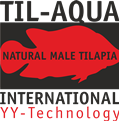Testosterone: Killing the tilapia industry
Banning hormone use and providing the better alternative
“Many researchers all over the world explored how androgen can interact with many of the fish body systems, particularly on fish immunity; however, rarely any of them tried to improve the hormonal methods or to find an alternative.”
Haitham G. Abo-Al-Ela, (2018)
Download full text here (English version) or here (Version française)
Testosterone: Background
Since the 70’s the tilapia industry has been using hormones to obtain all–male tilapia populations for on–growing. Male tilapia grows faster and the lack of females stops reproduction. A traditional method of obtaining an all-male population is to reverse the sex of the females into males. This procedure means administrating 17–Alpha–Methyltestosterone to the fish through the feed for at least the first 21 days of the fish’ life.
Testosterone: Threatening the industry
For more than a decade the industry has increasingly challenged by (emerging) diseases: Streptococcus spp, Francisella, Infectious Spleen and Kidney Necrosis (ISKN) and recently Tilapia Lake Virus (TiLV). Mortality-rates up to 75% in the hatchery phase are accepted as “normal” and simply covered by increasing the fry production. Even in later stages of the fish’ life, the mortality continues. These problems occur globally and require a huge economic offer; millions are invested compensating mortality, running vaccination programs and so on.
Impact: Decreasing fish health
Various effects of testosterone on the fish’ health have been indicated which have a direct negative effect on survival and performance:
– Disruption immune system development 1)
– Decreased mucus production
– Decreased immune-system cell levels 2)
– Abnormal embryonic development 1)
– Targeting immune-related organs (f.i. liver and kidney) 1)
Impact: Weakening the species
Another very alarming effect of testosterone on the fish health is partially indirect. As such it poses an even larger threat to the tilapia industry. It is called the ‘genotoxic’ effect1).
In genetics, genotoxicity describes the property of chemical agents that damages the genetic information within a cell causing mutations.
This means not only the current generation is affected, but also that the general robustness of the species is increasingly(!) weakened through each new generation.
With the above in mind, one should take into account 50 years of unrestrained use of androgens…
Impact: Aquatic ecosystem
The impact on the aquatic ecosystem can be both in the fry phase as well as in the adult phase.
For the fry which are reared in a hatchery, it is the water that is discharged which can pollute the ecosystem and affect non-target species 1).
For the adult fish, it are the fish themselves that can ‘pollute’ the ecosystem by either escaping or by being used for restocking purposes. Half of the fish that have been sex-reversed with testosterone are actually females that look and act like a male but in their genes are still females (XX). Sperm of these ‘males’ will exclusively carry X chromosomes. Reproduction of these fish with wild fish will cause an increased female ratio for the next generations.
Impact: operators and caretakers
Some countries have forbidden the use of hormones for sex-reversal while in other countries legislation is lacking. Faulty procedures in feed preparation and application expose the operators to the negative effects of this hormone 3).
Testosterone: The end?
As Mr. Michael Phillips (Director of Science and Aquaculture, WorldFish) stated in March 2017: “Tilapia was always considered to be one of the most robust fish in aquaculture.” The issues regarding the tilapia health status are “a sign that greater efforts will have to be made to ensure tilapia’s hardy reputation.”
The industry must ban the use of hormones as quickly as possible. For the health of the tilapia itself but also for the health of the industry. The proposed alternative of YY Males 1) is now readily available and poses the more efficient and sustainable solution for the tilapia industry. The obtained offspring is stronger 4) and the aforementioned impacts would be tackled.
Literature
1) Haitham G. Abo-Al-Ela, 2018, Hormones and fish monosex farming: A spotlight on immunity, Fish and Shellfish Immunology 72 (2018) 23–30
2) Sayed and Moneeb, 2015, Haematological and biochemical characters of monosex tilapia cultivated using methyl-testosterone, The Journal of Basic & Applied Zoology (2015) 72, 36-42
3) Meghowon and Mojekwa, 2014, Testosterone and its effect on Fish, Man and environment, Biotechnology 13 (5), 213-216
4) OiE, 2018, A Tilapia Lake Virus (TiLV) disease card
